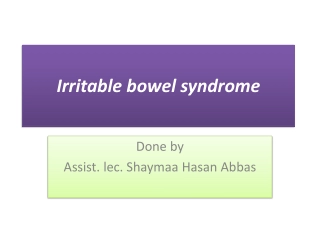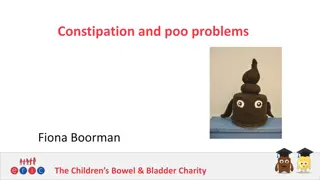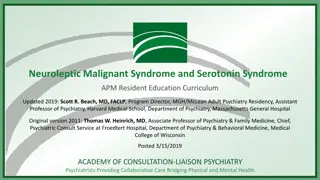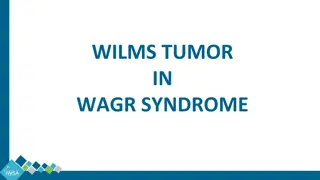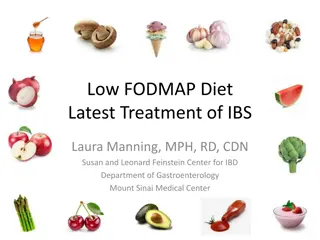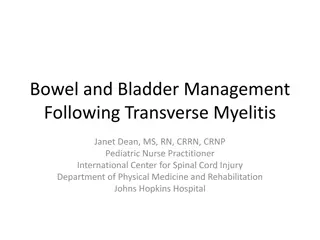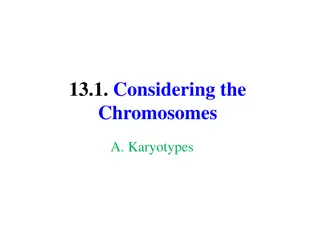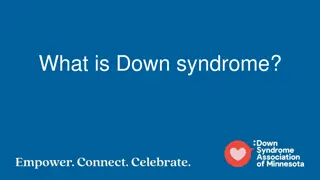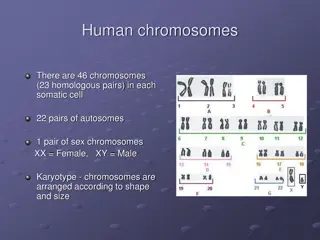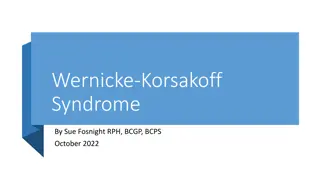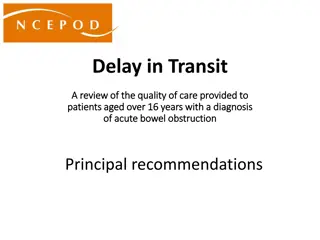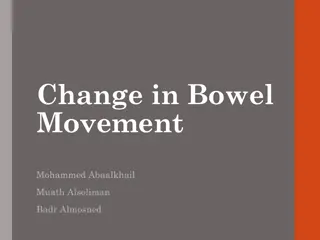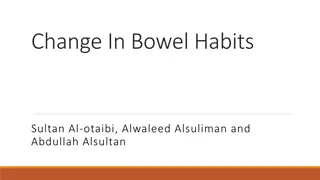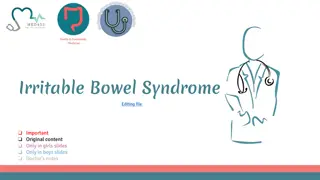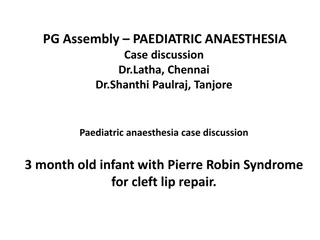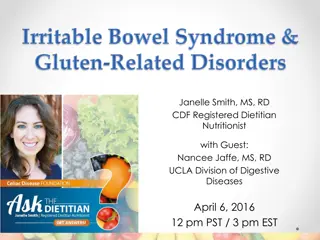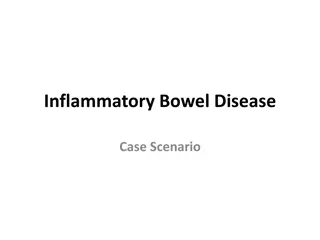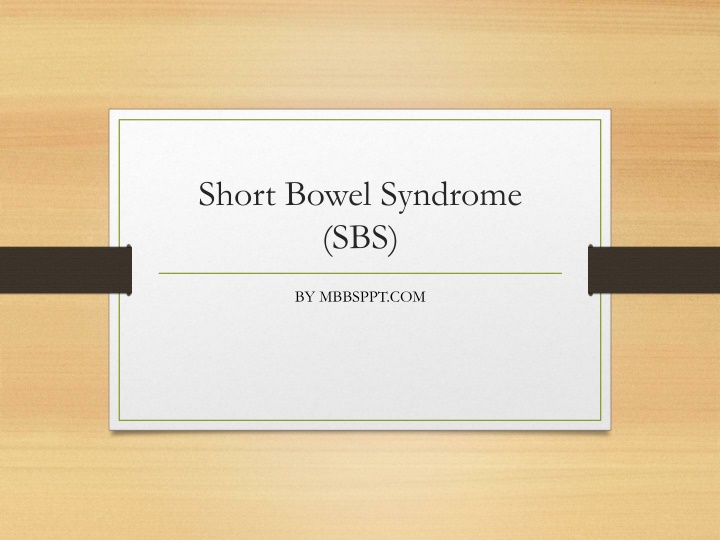
Short Bowel Syndrome (SBS)
Short Bowel Syndrome (SBS) is a condition characterized by the inability to maintain proper nutrient absorption due to surgical resection, congenital defects, or diseases affecting the small intestine. This article discusses the definition, etiology, manifestations, and pathophysiology of SBS, shedding light on the challenges faced by patients with this condition.
Download Presentation

Please find below an Image/Link to download the presentation.
The content on the website is provided AS IS for your information and personal use only. It may not be sold, licensed, or shared on other websites without obtaining consent from the author. If you encounter any issues during the download, it is possible that the publisher has removed the file from their server.
You are allowed to download the files provided on this website for personal or commercial use, subject to the condition that they are used lawfully. All files are the property of their respective owners.
The content on the website is provided AS IS for your information and personal use only. It may not be sold, licensed, or shared on other websites without obtaining consent from the author.
E N D
Presentation Transcript
Short Bowel Syndrome (SBS) BY MBBSPPT.COM
Definition Defined as a type of intestinal failure which results from surgical resection, congenital defect or disease associated loss of absorption and is characterized by the inability to maintain protein energy, fluid, electrolyte or micronutrient balances when on a conventionally accepted normal diet. MBBSPPT.COM 2
Intro Due to functional or anatomical loss of extensive segments of small intestine so that absorptive capacity is severely compromised Extensive segments - Less than 200 cm of viable small bowel or loss of 50% or more of the small intestine places the patient at risk for developing SBS. MBBSPPT.COM 3
Etiology Adult Mesenteric ischemia- thrombosis and embolism of superior mesenteric vessels Crohn s disease Radiation enteritis Neoplastic Motility disorders Trauma Pediatric Necrotizing enterocolitis Multilevel small- bowel atresia Midgut volvulus with ischemic bowel infarction MBBSPPT.COM 4
Intro Manifestations: Malabsorption Diarrhea Steatorrhea Fluid and electrolyte disturbances Cholelithiasis Bone disease Gastric acid hypersecretion Liver MBBSPPT.COM 5
Pathophysiology Nutrient, electrolyte, fluid absorption capacity are proportional to the length of residual small intestine Functional impairment depends on : Length of intestine Segments of intact bowel The absorptive quality of remnant bowel Inter-individual variability in adaptation MBBSPPT.COM 6
Pathophysiology Jejunal Resection: Digestive enzymes greatest proportion of digestive enzymes are conc. in villi of jejunum-initial reduction in absorption of nutrients until adaptation. Loss of physiological GI feedback mechanisms results in rapid gastric emptying If <100 cm remains net secretory response to the food. MBBSPPT.COM 7
Pathophysiology Ileal resection : Normally most of 8-9 liters of secretions are reabsorbed by ileum -if <100cm of ileum left insitu net secretory response to food Site of absorption of B12 and bile salts results in bile salt & fat malabsorption and anemia Feedback mechanisms (peptide YY,GLP1) which detect malabsorption are altered MBBSPPT.COM 8
Pathophysiology Loss of ileocecal valve: Small bowel dilatation and slower motility Increased risk of bacterial overgrowth Competition for nutrients, bacterial translocation & endotoxemia, lactic acidosis MBBSPPT.COM 9
Pathophysiology Colon in continuity : In adaptation process colon adapts the role of digestive organ It slows the transit time and stimulate intestinal adaptation compensate for lack of small bowel reabsorbs water, electrolytes &SFA Flora of colon ferment carbs to SFA when absorbes provides 500kcal/day MBBSPPT.COM 10
Adaptation The physiologic changes and adaptation of patients with short-bowel syndrome can be viewed in two phases. Acute phase Adaptation phase MBBSPPT.COM 11
Adaptation Acute Phase: The acute phase occurs 24-48hrs after massive bowel resection. It is associated with malnutrition and fluid and electrolyte loss through the GI tract. Enteral feedings may also be initiated, but it should be relatively slow. Patients with less than 100 cm of small intestine will require TPN. MBBSPPT.COM 12
Adaptation Adaptation phase: The adaptation phase generally begins 2-4 days after bowel resection and may last up to 12-18 months. During this phase, up to 90% of the bowel adaptation may occur. Villous hyperplasia Increased crypt depth Intestinal dilatation occur. Early low volume continuous feedings may reduce the duration of TPN. MBBSPPT.COM 13
Complications EARLY 1.Diarrhea and electrolyte disturbances: Electrolytes are secreted in jejunum and ileum loss of these segments net electrolyte losses Even if sr.magnesium and potassium levels are maintained, body electrolytes are reduced to diagnose - check urinary electrolyte levels MBBSPPT.COM 14
Complications 2. Gastric hypersecretion : Loss of negative feedback may persist upto 6months lead to peptic ulcers, oesophagitis. MBBSPPT.COM 15
Complications LATE : Metabolic complications TPN related complications Bacterial overgrowth Micronutrient deficiencies MBBSPPT.COM 16
Management Strategies: Increase absorption: ORS Antimotility agents Adaptation Teduglutide Nontransplant surgical treatment REPLACEMEN T: Fluid,nutrients,ele ctrolytes MBBSPPT.COM 17
Early Goals Fluid and electrolyte management : Begin TPN within first 24 hrs (25-35kcal/kg/day) Measurement and replacement of fluid losses and electrolytes every 2hrs Blood glu every 4hrs If Remaining jejunum 75 cms likely longterm TPN 100cm tpn + fluid supplements 200cm ors will be necessary MBBSPPT.COM 18
Management Introduction of enteral nutrition : Initially low rate continuously (enteral tube) trickle feeds 5% of daily requirement advanced every 3- 7days Diet should be of high fat and protein 40% of requiring to minimize osmotic diarrheal complications MBBSPPT.COM 19
Management Pharmacological adjuncts : Antimotility agents loperamide, clonidine, codeine Decrease secretions octreotide decreases pancreatic secretions & increases small intestine transit time Cholestyramine in steatorrhea secondary to bile acid malabsorption following ileal resection PPI and H2 receptor blockers reduce acid secretion MBBSPPT.COM 20
Management Methods to promote adaptation Glutamine, Growth Harmones, diets high in carbs stimulate adaptation process GLP-2 analogue (teduglutide) is under studies. MBBSPPT.COM 21
Prevention of Complications Supplementation of vitamin D calcium and magnesium Treat bacterial over growth in small bowel which can cause metabolic acidosis Prevent catheter related sepsis PN related liver disease multifactorial Maximizing enteral calories Avoid over feeding Prevent specific nutrient deficiencies MBBSPPT.COM 22
Surgical Therapy Aim is to preserve the intestinal remnant length Avoid resection much as possible MBBSPPT.COM 23
Methods to Slow Intestinal Transit Patients with marginal remnant, 60 -120cm They have rapid transit Reversing 10 15 cm segment yielded good results Segment of colon interposed in either antiperistalsis direction Other options Creation of artificial valves not successful Retrograde intestinal pacing with electrodes MBBSPPT.COM 24
Methods to Increase Intestinal Area Longitudinal intestinal lengthening and tailoring (LILT) Bianchi procedure Allocate terminal blood vessels anatomically to the either side of the bowel wall This is mainly used in children particularly- significantly dilated residual intestine, dismotility, bacterial over growth MBBSPPT.COM 25
Bianchi Procedure MBBSPPT.COM 26
Serial Transverse Enteroplasty (STEP): MBBSPPT.COM 27
Methods to Increase Intestinal Area Serial transverse enteroplasty (STEP): Repeated applications of linear stapling device from opposite directions in zig zag fashion Requires diameter at least 4 cm Recurrent dilatation can managed in similar fashion 80% of patients improve clinically STEP is preferable than Bianchi procedure MBBSPPT.COM 28
Intestinal Transplantation Indicated in 1. Patients with life threatening complications due to intestinal failure 2. 3. 4. 5. 6. Those destined for lifelong TPN Thrombosis of 2 or more central veins 2 or more episodes of cathter related sepsis Singe episode of line related fungemia septic shock, ARDS Frequent episodes of severe dehydration despite IV supplementation MBBSPPT.COM 29
Intestinal Transplantation 2 Types 1. 2. Isolated intestine transplantation Combined intestine + liver transplantation Combined transplant is done in patients with end stage liver disease MBBSPPT.COM 30
Intestinal Transplantation Complications : Anastomotic leaks Spontaneous bowel perf Hepaticartey thrombosis Infection REJECTION Acute rejection can be diagnosed by loss of villi and immune cell infiltrate MBBSPPT.COM 31
Intestinal Transplantation Survival rates are 90 % at 1yr 70 % at 3yrs for intestine only transplants 70% at 1 yr and 68% at 3 yrs for combined transplants MBBSPPT.COM 32
Conclusion Best thing to do in SBS is to prevent it by resecting the bowel as little as possible. MBBSPPT.COM 33

